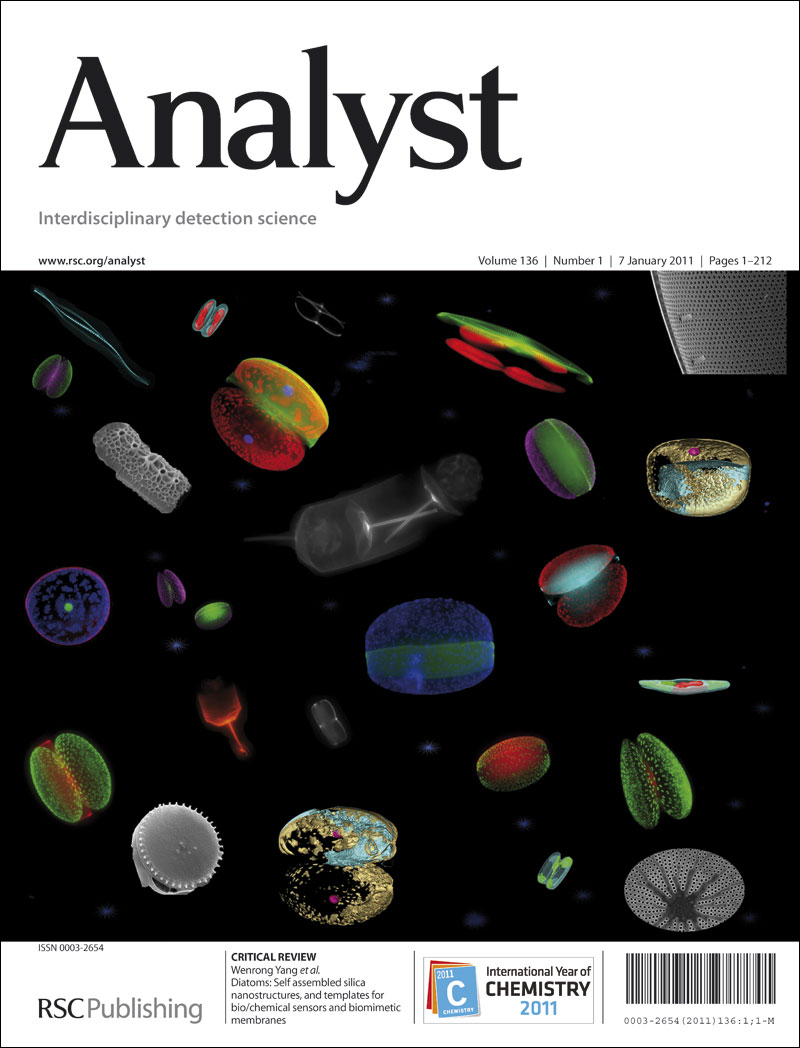利用聚亚甲基蓝和还原氧化石墨烯纳米复合材料修饰的丝网印刷电极对尿酸和黄嘌呤进行比率和同步电化学分析
IF 3.3
3区 化学
Q2 CHEMISTRY, ANALYTICAL
引用次数: 0
摘要
本研究采用聚亚甲基蓝(PMB)和还原氧化石墨烯-碳纳米管(rGO-CNT)纳米复合材料对丝网印刷碳电极(SPCE)进行改性,设计了一种简便、灵敏的比例电化学传感器,用于同时检测尿酸(UA)和黄嘌呤(XT)。以PMB为内参,在电沉积/共还原合成的rGO-CNT/SPCE上通过电聚合制备PMB。采用场发射扫描电镜、傅里叶变换红外光谱和电化学阻抗谱对PMB/rGO-CNT/SPCE进行了表征。采用循环伏安法和方波伏安法(SWV)评价了UA和XT在PMB/rGO-CNT/SPCE上的电化学行为。采用田口法确定最佳实验参数。该传感器对UA的检测限为2.1 μM,对XT的检测限为1.3 μM,对SWV的比值信号具有良好的选择性和重复性。用牛血清白蛋白溶液和人血清的标准加入法对实际样品进行了测试。此外,PMB/rGO-CNT/SPCE传感器被证明既环保又实用。因此,PMB/rGO-CNT/SPCE传感器是一种可靠、有效的UA和XT检测工具,适用于相关疾病的诊断、治疗和管理。本文章由计算机程序翻译,如有差异,请以英文原文为准。
Ratiometric and simultaneous electrochemical analysis of uric acid and xanthine using poly(methylene blue) and reduced graphene oxide nanocomposite-modified screen-printed electrode
This study introduces a facile and sensitive ratiometric electrochemical sensor based on the modification of a screen-printed carbon electrode (SPCE) with poly(methylene blue) (PMB) and reduced graphene oxide-carbon nanotube (rGO-CNT) nanocomposites for the simultaneous detection of uric acid (UA) and xanthine (XT). PMB, used as an internal reference, was prepared via electropolymerization on the rGO-CNT/SPCE synthesized through electrodeposition/co-reduction. The PMB/rGO-CNT/SPCE was characterized using field emission scanning electron microscopy, Fourier transform infrared spectroscopy, and electrochemical impedance spectroscopy. The electrochemical behavior of UA and XT on PMB/rGO-CNT/SPCE was evaluated using cyclic voltammetry and square wave voltammetry (SWV). The optimal experimental parameters were determined by the Taguchi method. The sensor displayed a detection limit of 2.1 μM for UA and 1.3 μM for XT, and exhibited excellent selectivity and reproducibility, using ratiometric signals from SWV. Tests on real samples were conducted using the standard addition method with a bovine serum albumin solution and human serum. Furthermore, the PMB/rGO-CNT/SPCE sensor proved to be both environmentally friendly and practical. Therefore, the PMB/rGO-CNT/SPCE sensor is a reliable and effective tool for detecting UA and XT, applicable to the diagnosis, treatment, and management of related diseases.
求助全文
通过发布文献求助,成功后即可免费获取论文全文。
去求助
来源期刊

Analyst
化学-分析化学
CiteScore
7.80
自引率
4.80%
发文量
636
审稿时长
1.9 months
期刊介绍:
"Analyst" journal is the home of premier fundamental discoveries, inventions and applications in the analytical and bioanalytical sciences.
 求助内容:
求助内容: 应助结果提醒方式:
应助结果提醒方式:


